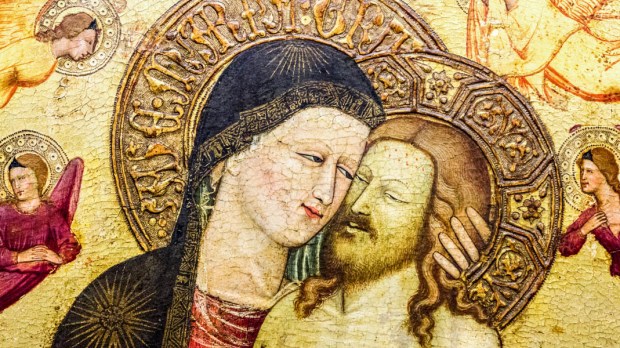[Once he was weaned…]Hannah brought Samuel with her,along with a three-year-old bull,an ephah of flour, and a skin of wine,and presented him at the temple of the LORD in Shiloh.After the boy’s father had sacrificed the young bull,Hannah, his mother, approached Eli and said:“Pardon, my lord!As you live, my lord,I am the woman who stood near you here, praying to the LORD.I prayed for this child, and the LORD granted my request.Now I, in turn, give him to the LORD;as long as he lives, he shall be dedicated to the LORD.”She left Samuel there. (1 Samuel 1:24-28)
It used to be a common thing to dedicate the firstborn to God. In fact, Luke reminds readers of that, when he tells of Jesus’ presentation in the Temple: … just as it is written in the law of the Lord, “Every male that opens the womb shall be consecrated to the Lord,”Luke 2:23, and Hannah, who had fervently prayed for the gift of a son, was obliging, but it could not have been easy to leave her beloved child behind. Among the offerings she brought to the temple, the greatest was the piece of her own flesh, cut from her and forever left behind, for the sake of her covenant with God.
Kind of like a maternal circumcision — the female’s portion of the blood covenant between Abraham and God.
Every covenant that involves God will, in the end, have something to do with blood. We beg for our babies, bear them in blood, and eventually we dedicate them (male and female) to God. If we don’t do it intentionally, at some point we will do it by accident, usually during a moment of high anxiety for the child, when we are at our most vulnerable: “Heal my child, and he is yours, if you want him, Lord.” “Only protect her, Lord, keep her safe and she is yours.”
Every covenant contains that component of blood and of the giving up of oneself, even the covenant of marriage — at least it did back when the hymen was considered something more than “a bit of meaningless tissue” as it is, today. Over the centuries, the meaning of blood within a marital bed has become perverted, reduced to human ideas of pride and “purity” and familiar honor. But it was never about those things. It was about the way a human marriage reflects (and helps to sustain) the blood covenant between heaven and earth, between humanity and the Bridegroom who redeems it.
It is an testament to enduring faithfulness, bound by nothing less than blood.
But in the Nativity of Christ the blood of the covenant is uniquely commingled. It is Mary’s own blood that nourished into life the Incarnation, that God’s own blood might be shed for us, to sustain and nourish us in return.
This is a great mystery; we shouldn’t shy away from it simply because the sight or subject of blood makes us uncomfortable.
The blood has been at the heart of our relationship to God, from the very beginning. It will be so, until the end. And one way or another, we all participate in its shedding and sharing.
A small bit of related trivia: In Traditional Chinese Medicine, when the blood is considered sluggish or stagnant, myrrh is used, because myrrh “moves the blood.” When myrrh was presented by the Magi, we might consider that it was part of what moved the blood covenant forward, into the era of this redemptive marriage between creature and Creator.
What a lot to think about, as Advent draws to a close.
Come, Lord Jesus, and instruct us in these mysteries; bring your Light to bear on them, that we may grow in Wisdom and understanding, in pursuit of our ever-deepening relationship with you. Amen.
~
Aleteia is bringing you reflections — Advent Light — for each day of this 2017 liturgical season. Follow the series here.

